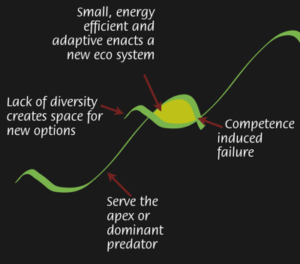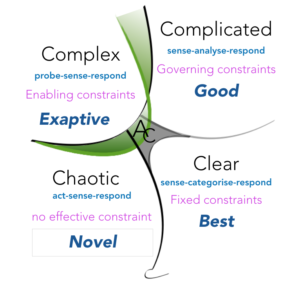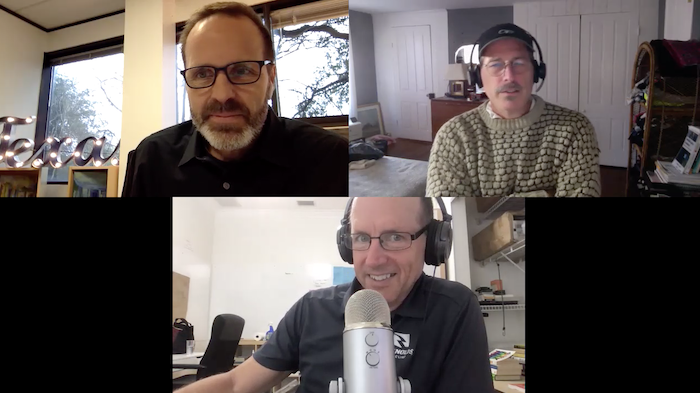The “Agile C-Suite” and Its Role in Growing an Adaptive, Resilient Organization
My previous post focused on the Harvard Business Review (HBR) article “The Agile C-Suite”1.
In the Forbes article “Agile Isn’t New: What’s New Is The C-Suite Embracing It”2, Steve Denning provides his own perspective on the HBR article, as well as additional insights that help get readers closer to embracing the realities of shifting toward agility.
The title sets up the obvious–Agile isn’t new, but having C-suite level executives embrace it is. That is largely due to how the Agile movement got started and where the vast majority of emphasis has been over the years–on IT and/or Software Development teams. This myopic view of Agile has been an impediment to organizational and business adoption.
I particularly appreciate that Denning starts off by taking an “Economic” view of agility in the C-Suite, by comparing stock performance.

According to Denning, Amazon has been successful, in part, because of Jeff Bezos’ understanding of market position, combined with a focus on customer value. Microsoft’s Agile success was initially a grass-roots movement that grew and then became institutionalized after Satya Nadella became CEO.
By contrast, GE and IBM have very different trends in terms of market capitalization. In IBM’s case, their focus on shareholder value is at odds with their underlying fundamentals and decision-making.
I’ve been saying for years that Agile has always been more about enabling an adaptive business, with a focus on the customer and value optimization, not just about developing software. However, because of its deep IT/software roots, that has been obscured. We have certainly begun to see a shift in recent years and one key lagging indicator of that shift is executive leadership embracing Agile as a business imperative. Likewise, the latest trend and emphasis on “Business Agility” is nothing new. It’s just that we’re finally starting to see real evidence that we’ve “crossed the chasm” of Agile for IT only and have figured out how to position it in a way that makes sense to business leaders.
Denning’s Laws of Agile
In his assessment of the HBR article, Denning suggests that “Agility begins at the top, is inspired by the top, and is embodied in how the top conducts itself.” He goes on to state that “The starting point of agility is the passionate, and even obsessional, pursuit of a crystal-clear mission of the organization. In the case of the private sector, this is value for customers”, what he calls “The Law of the Customer”.
I agree. The first responsibility of leadership is to define and articulate the Vision–compelling purpose–for why we do what we do and why we would be embarking on an Agile transformation or another challenging change initiative. Focusing on the Customer is a key pillar of Agile. Our Path to Agility® framework is a Business Outcomes-based approach. My ‘favorite’ Business Outcome to focus on is Customer Satisfaction, which is described and measured as Customers are satisfied with the experience, benefits, and outcomes when using your product or service.
Denning also references the “Law of the Small Team”, which means “unleashing the creativity of the staff by breaking the work into small pieces that can be handled by small self-organizing teams, working in short cycles with direct feedback from customers” and the “Law of the Network”, which addresses C-Suite leadership’s “responsibility to establish and maintain a hierarchy of competence rather than a bureaucratic hierarchy of authority ” and to “ensure that information flows horizontally to wherever it is needed, not just vertically, and to create an atmosphere of transparency where problems are aired and discussed openly”.
A common refrain amongst agilists is that we need small, self-organizing teams. While that sounds obvious, it’s actually complex. Traditional organizational structures and years of resource utilization emphasis make this difficult to change and sustain. Then there’s the cultural aspect of self-organization, which is in competition with traditional command and control cultures.
For these reasons, I strongly advocate for cultural awareness as the critical starting point for leaders. If leaders aren’t able to understand their organization’s cultural profile, as well as the dynamics of culture and change, then they will be more likely to see the organization struggle and create more churn than progress.
Next, I emphasize the need for distributed decision making. This gets us beyond the base principle of self-organizing teams to address the points at which critical decisions need to be made on a regular basis. Experience has taught us that those who are closest to the situation are most likely in the best position to decide how to deal with it.
So understanding and enabling the “network” is a key to sustainable agility. We address this in Path to Agility by building the capability to understand and address the impact to organizational structure (new roles, team design, management structure, hierarchies, etc.) and to get teams aligned to value streams that are cross-functional and can minimize dependencies and handoffs.
What does it mean to “Embrace” Agile?
Denning continues by stating, “One of the most difficult things for the C-suite to grasp about agility is that it involves a different way of thinking as much as a different way of doing.”
I don’t think that executive leaders don’t “grasp” agility as a mindset, but that they often treat it as something that needs to be implemented. It’s thought of as transactional. As such, too much emphasis goes into doing agile and little into ‘being agile’ or thinking about what agility means across the organization. Leaders commonly think it’s something for the teams to do. Accepting it as a mindset that has to be internalized is much less straightforward. There can be a lot of anxiety and discomfort when it comes to thinking differently, versus just doing something differently.
Truly embracing Agile is so much more than just sponsoring or funding an Agile transformation. I’ve seen this play out a few times before. Two instances, in particular, stand out where Agile was compartmentalized, hindering adoption.
In the early stages of an Agile transformation for Company “A”, I was working with C-Suite leadership, as well as their direct reports. I was coaching leadership on how to think about and communicate the intent and prioritization for their Agile transformation. I noticed early on that, during his weekly leadership team meetings, the CIO would make the statement that “Agile is just another tool in our toolbox”. After hearing him make this statement multiple times over the next few weeks, I spoke up. I respectfully challenged the statement and encouraged everyone to think about it as a “strategic capability”. That proved to be the beginning of the end of my coaching relationship with him. It turns out, some leaders don’t like being called out in public (who knew?). Once the CIO showed that he didn’t really embrace Agile, most of his leadership team began to dismiss it as well, and their Agile transformation inevitably failed.
About a year later, I was kicking off a new engagement at Company “B” and had my first introduction meeting with the CIO and his team. During that initial meeting, he made the exact same comment, that “Agile is just another tool in our toolbox”. I couldn’t help but wonder–Was there some article in CIO magazine that used this phrase? Having learned my lesson in the earlier scenario, I did not publicly challenge this CIO. I waited and asked him about it in private. Again, I encouraged him to think about Agile in more strategic terms rather than as “a tool”. I was hopeful that, in this case, it would not be a precursor for another failed Agile transformation. Ultimately, same mindset, same result.
In both of these examples, the companies never reached a level of sustainable, organizational agility. They both plateaued, with a few pockets of Agile teams, and eventually retreated back to the way things had always been done.
For both companies, the lack of C-Suite leadership ‘embrace’ of Agile as a strategic business imperative, was compounded by a form of complacency. They were highly profitable and had little perceived threat from competitors. This is what Dave Snowden refers to as the Apex Predator theory, which relates to a period of stability or dominance, but when instability or uncertainty occurs things get problematic. When things are going well, there’s often no motivation for leaders to think about being adaptive. For most of us, we were likely much more confident, or complacent, in January 2020 than we were in March 2020. Things can change quickly and on a massive scale.

Resilience
“We value Responding to Change over following the Plan” – Agile Manifesto4
There are two ways an organization can choose to respond to change:
- Resist–Attempting to prevent external influence, building boundaries, and control systems
- Adapt–Generating the appropriate response required for balance, emphasizing distributed decision-making, and self-organization where needed
Robustness and resilience are general characteristics of self-organizing systems through their capacity to resist change and their capacity to adapt to it.
To paraphrase Dave Snowden–moving from an organization designed for robustness to one designed for resilience represents a significant strategic shift. Most organizations have been designed to be robust, to prevent failure, which actually increases complexity. A resilient organization accepts that failure is inevitable and focuses on frequent, early discovery, and adaptiveness in order to quickly recover.
To highlight this, I took a look at the year-to-date stock trends for Amazon, Microsoft, GE, and IBM, since Denning had established that as an indicator. Each of them took a significant dip when the Covid-19 crisis ramped up in March, but both Amazon and Microsoft have shown the ability to rebound rather well, while GE and IBM remain below pre-covid-19 prices.

I did a similar comparison for Company “A” referenced in the example above. (Company “B” is not publicly traded)
Company “A”’s stock price trend–3 years and year-to-date:

Looking at these stock price trends amplifies the shift from robust to resilient. Seeing a growth in stock price, as market share or revenue increase is expected. Resilience is needed when markets shift or become uncertain, as we have now, and the ability to detect threats and adapt or recover quickly. *Of course, there are multiple variables relating to stock price and Agile is at best a correlation and not a causation.
Coming back to ‘Why’
I believe the real compelling purpose for organizational agility is to build resilience. Organizations are less resilient when C-Suite, and all other leaders, don’t truly embrace an Agile mindset.
Why? Because everyone else in the organization will behave as they see their leaders behave. It’s critical for leaders to model the behaviors and mindsets that they expect to see in their people.
Denning frames this quite effectively–“These different ways of thinking, perceiving and acting in turn generate characteristic attitudes, values, modes of thought and approaches to problems…. In effect, the Agile mindset reflects the emergence of a fundamentally different kind of management.”
I appreciate that both the Denning and Bain articles point out the need for leadership humility and managers as coaches. As a Coach, I try to lead with humility and curiosity. I coach leaders to do the same. Modeling that behavior for the rest of the organization shows they are actually embracing an Agile mindset and significantly improves the opportunity for sustained agility.
So, that’s the challenge–Are leaders willing to go through their own transformation in order for the rest of the organization to transform?
If the threat is strong enough, I expect the majority would accept the challenge. It may be obvious today, given the global pandemic-driven economic crisis. Although, counterintuitively, the overwhelming reaction I’ve seen in times of market uncertainty or volatility is for Leaders and organizations to abandon Agile mindset and principles and retreat to old thinking. This is a resistant reaction.
If you’re a C-Suite leader, who really embraces an Agile mindset, then you’ll inherently double-down on the things that enable adaptiveness, rather than abandoning them.
Are you viewing Agile as “just another tool in the toolbox” or is it your strategic, survival guide?
Acknowledgments:
- Darrell K. Rigby, Sarah Elk, and Steve Berez Bain & Co. – HBR article – (https://hbr.org/2020/05/the-agile-c-suite)
- Steve Denning – Forbes article – (https://www.forbes.com/sites/stevedenning/2020/05/03/agile-isnt-new-whats-new-is-c-suite-embracing-it/#6c86e5705e5e)
- Dave Snowden – Cognitive Edge (https://cognitive-edge.com/)
- Agile Manifesto (https://agilemanifesto.org/)

 The eagerly anticipated
The eagerly anticipated 

 Agile Velocity hosted a series of online conversations exploring the most crucial leadership questions of the day.
Agile Velocity hosted a series of online conversations exploring the most crucial leadership questions of the day.





 As a person who has a high preference for in-person workshops, transitioning to a 100% virtual delivery and facilitation has been an
As a person who has a high preference for in-person workshops, transitioning to a 100% virtual delivery and facilitation has been an 
